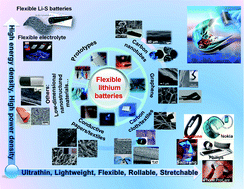With the advent of flexible electronics, flexible lithium-ion batteries have attracted great attention as a promising power source in the emerging field of flexible and wearable electronic devices such as roll-up displays, touch screens, conformable active radio-frequency identification tags, wearable sensors and implantable medical devices. In this review, we summarize the recent research progress of flexible lithium-ion batteries, with special emphasis on electrode material selectivity and battery structural design. We begin with a brief introduction of flexible lithium-ion batteries and the current development of flexible solid-state electrolytes for applications in this field. This is followed by a detailed overview of the recent progress on flexible electrode materials based on carbon nanotubes, graphene, carbon cloth, conductive paper (cellulose), textiles and some other low-dimensional nanostructured materials. Then recently proposed prototypes of flexible cable/wire type, transparent and stretchable lithium-ion batteries are highlighted. The latest advances in the exploration of other flexible battery systems such as lithium–sulfur, Zn–C (MnO2) and sodium-ion batteries, as well as related electrode materials are included. Finally, the prospects and challenges toward the practical uses of flexible lithium-ion batteries in electronic devices are discussed.
